Step into any car showroom today and you’ll be bombarded with a slew of monikers that encompass a wide range of safety technologies. From the anti-lock braking system (ABS) to traction control system (TCS), electronic stability control (ESC) and vehicle dynamic control (VDC), today’s cars carry with them technology that can even automatically apply the brakes to prevent you from accidentally hitting a car directly in front of you.
Of course, the salesman at the dealership will do his or her utmost best to convince you that these systems work as advertised. Nonetheless, there will always be skeptics who prefer the age-old “walk the talk” approach when it comes to such systems. It’s only natural for most people to be able to see something happen before they put any faith in them. Show me instead of telling me, right?
To demonstrate that its safety systems are capable of doing what is claimed, Infiniti Malaysia recently took it upon itself to set up a driving programme held at Desa Park City, Kuala Lumpur. The two-day event allowed customers and members of the media to experience first-hand, the level of performance and innovation that goes into each Infiniti product.
As with most practical driving programmes, the day kicked off with a short briefing, where we were introduced to our instructors for the day. Comprising of professional drivers from around the ASEAN region and beyond, participants were given a breakdown of the day’s activities before being split into separate groups and sent to each station.
This writer, along with other members of the media present during the day, were piled into one group. Our first activity, which was a two-part section, involving one of Infiniti’s finest, the Q50S Hybrid, where we will be testing it out its 3.5 litre naturally-aspirated V6 engine and 50 kW electric motor hybrid powertrain, along with its braking capability.
The premise of the exercise is simple. Mash the accelerator pedal before braking hard when you enter a stop zone. To introduce a bit of competition, our instructors challenged us to get the car to come to a complete stop before a certain point in said zone, where the person who comes closest to that point will be rewarded. Overshoot that point and you’re disqualified.
With a total system output of 364 PS and 546 Nm of torque, deciding when to slam on the brakes in the Q50S Hybrid is no mean feat. The car’s Direct Response Hybrid system allows it to sprint from 0-100 km/h in just 5.1 seconds, so carrying too much speed before braking is certainly a no-no. As our instructors explained, it’s all about getting the feel right and deciding which speed allows you to stop precisely where you can the car to be.
Easier said than done then as I found out during my three tries that either involved overshooting the point or braking a tad too early, and coming to a stop a good 50 cm away from the point. The instructors themselves had a go and their best result was 5 cm – an impressive feat indeed.
Following each acceleration and braking run, participants were then required to put their faith in the car’s Forward Emergency Braking (FEB) system that is standard on select variants of the Q50, including the Q50 2.0t GT Premium, Q50 2.0t GT Premium Sport and Q50S Hybrid.
In this hands-on demonstration, we were told to let the car roll towards a wall of crates. As we got closer to the crates, the car’s Predictive Forward Collision Warning (PFCW), with the aid of radar sensors at the front of the car, would beep to indicate that you are in close proximity to an object ahead, i.e., the wall of crates.
Normally, you would apply the brakes at this point but what if you didn’t? Well, that’s what we are here to simulate as we strongly fought the urge to stomp on the brake pedal. As the car’s beeps got more frequent, I expected the inevitable “fender bender” with the wall of crates but that was not to be, because the car’s FEB system applied the brakes automatically while the seatbelts were pre-tensioned before the car came to a complete stop, all without any human intervention.
On more than one occasion, the car did come into contact with the crates but the fault is with the driver, as our instructors explained. Should your foot lightly tap the brake pedal, the system detects and comes to a consensus that the driver is in control of the car, and thus disables the FEB system. Remember, this is a passive system that kicks into action during unintended incidents, i.e. dozing off while in traffic.
After the first heart-stopping activity was concluded, we were given a short break to refresh, before being led to the gymkhana course. Here, we were told that we will be experiencing Infiniti’s Direct Adaptive Steering (DAS), the world’s first steer-by-wire system fitted on a production vehicle. The system is a result of more than 10 years of research and promised many benefits.
Firstly, a little background info on the DAS. The steering system in the Q50 consists of three electronic control units (ECUs). These transmit the input from the wheel to the front wheels via data streams, instead of a traditional method of a having a physical shaft linking them. Two motors are responsible for generating the appropriate steering force and controlling the steering angle based on the driver’s input.
Even though the steering is completely digital almost all of the time, Infiniti didn’t forgo the conventional steering mechanism altogether in the Q50. There is still a mechanical linkage but unless the steer-by-wire system fails, which isn’t likely as the three ECUs act as a backup for each other, a clutch disengages the steering wheel to the steering rack under normal conditions.
Infiniti say the DAS system provides a comfortable ride and handling feel akin to driving on a smooth pavement surface, even though the vehicle is riding on grooved or rough roads. This means that drivers will not have to endure sudden jolts coming through the steering, as the system isolates these road disturbances and surface changes, improving straight-line ability.
The system is even customisable, depending on your preference. If you’d like a heavier steering feel or a quicker response, simply key in the settings via the Q50’s touchscreen unit and you’re set. Obviously, we had to put the system through its paces and before being introduced to DAS, we set off in the entry-level Q50 2.0t GT (white car) that does not come with said system.
Driving through the tight gymkhana course was a bit of a challenge, as the steering was still a little heavy to direct the car through each turn quick enough. Even riding through the bumps, I had to adjust my steering to ensure the car remained straight and true due to the shocks introduced to the steering wheel.
Jumping into the silver Q50 2.0t GT Premium that comes standard with DAS and 18-inch five-spoke wheels, the differences were immediately apparent. Not only could I adjust the steering to respond quicker to suit the course, but while driving over the bumps, the car continued on its straight course, with zero “kickback” feel coming through the steering as the above video shows.
After both car park activities were accomplished, the final day’s activity involved a short road drive in a selection of Infiniti cars, including the Q50, QX70 crossover and the behemoth that is the QX80. My driving partner and I decided to go with the Q50 that packed features such as adaptive cruise control, lane departure warning and prevention, blind spot warning and distance control assist.
On the 50 km route, our Q50 managed to keep a safe distance while adjusting its speed to match the car ahead on the highway. The car also warned us of any surrounding cars (blind spot included) whenever we indicated to switch lanes. It even lightly intervened to keep the car in lane with the aid of a camera at the front tracking the white lines on the highway. Should you try to switch lanes without using the indicators, the car will assume that you are drifting away from the lane and through the DAS, will ensure to keep the car on track, a little startling at first.
The Infiniti Drive was certainly an eye-opener to the technologies that can be found in Infiniti’s vehicles. To be able to experience these systems in action is certainly a wonderful treat, knowing that they make your daily drive just that bit more convenient and pleasant, and safeguarding you during emergency situations.
Looking to sell your car? Sell it with Carro.

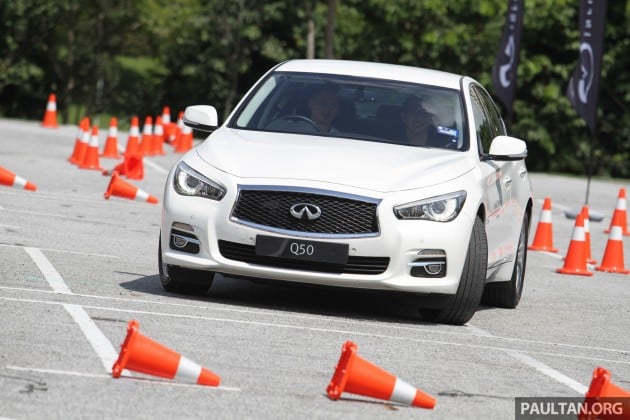






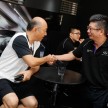
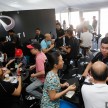
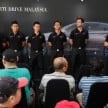
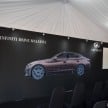

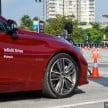

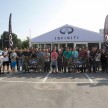

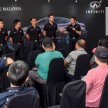

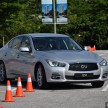
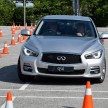
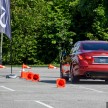
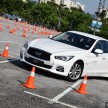
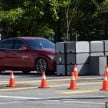
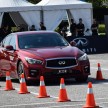
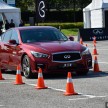
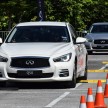
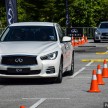
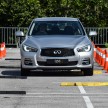
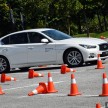

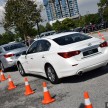
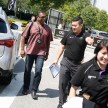
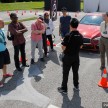
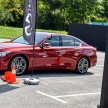
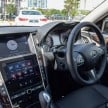
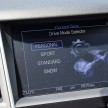
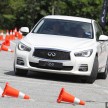

Finally a car that can train Malaysian drivers to use their indicators when turning or switching lanes. No indicators, no turning and the steering intervenes to bring them back to their lane.
Infiniti’s engine is very nice; they claim its from Mercedes.
The best of the lot is the titanic QX80 – 5.6L V8 400hp monster. It is even taller than the Alphard.
there’s only one q50 in all of the klang valley, brown with selangor plate.
seriously the ONLy q50 i ever saw
You sure? I saw a couple of Q50’s here and they looked superb.